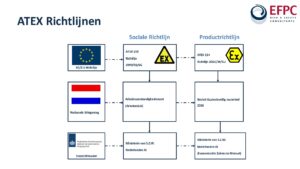ATEX: ATmosphères EXplosibles
ATEX is important for most companies dealing with flammable substances and should definitely not be forgotten.
Often, however, companies are unclear about what ATEX entails and why ATEX requirements need to be met. That is why we answer the most important questions for you.
Read more:
Download:
What does ATEX entail?
ATEX is an abbreviation and stands for ATmosphères EXplosibles, the explosive atmospheres. The word atmosphere refers to the air in the workplace. In this atmosphere, a flammable substance, vapour, gas or mist can mix with the oxygen in the air. At the right mixing ratio, this atmosphere becomes explosive.
What is explosion safety?
Safety is paramount in explosion protection, as explosions endanger workers’ lives and health due to the uncontrolled effects of fire and pressure, the presence of toxic reactive products and the consumption of oxygen in the ambient air that workers breathe.
The Working Conditions Act (ARBO Act for short) stipulates that the employer must take the necessary measures to protect the safety and health of employees, including measures for the prevention of occupational hazards, information and training, as well as organisation and necessary resources.
The employer must therefore ensure that measures are taken, both organisational and technical, to prevent explosions.
For this purpose, under Article 153 of the Lisbon Treaty, Directive 1999/92/EC was drawn up. This Directive is also known as the ATEX 153 Directive.
In the end, the employer is responsible for ATEX measures
.
What is an ATEX zoning?
Hazard zoning is a method of analysing and classifying the environment where explosive atmospheres may occur to enable the proper selection and installation of equipment that can be safely used in that environment. Hazardous places are divided into (ATEX) zones according to the frequency and duration of occurrence of an explosive atmosphere
What ATEX zones are there?
With regard to gas explosion hazards, a distinction is made between the following hazard zones:
– Zone 0;
– Zone 1
– Zone 2
– Deviant Area
– Inert Area
– Non-Hazardous Area
With regard to dust explosion hazards, a distinction is made between the following hazard zones:
– Zone 20;
– Zone 21
– Zone 22
– Inert Area
– Non-Hazardous Area
What is an Explosion Protection Document (ESD)?
An Explosion Protection Document is a document in which the hazards associated with explosive atmospheres and the particular risks that may arise from them must have been assessed and recorded in writing. For example, the Explosion Safety Document should address the following aspects:
a. a description of the operations;
b. a description of the processes/activities;
c. representation of the organisational measures to prevent explosion hazards;
d. documentation of the measures and modalities of coordination to protect against explosion hazards;
e. hazard zone classification;
f. indication of the procedure when identifying explosion risks;
g. risk assessment ignition sources.
What is the function of ATEX 153?
ATEX 153 is a supplement to the European Social Directive 89/391/EEC ‘Safety and Health of Workers at Work’ and deals with protection of workers at risk from explosive atmospheres. It is the 15th supplement to this directive, the official name being 1999/92/EC ‘Protection of workers at risk from explosive atmospheres’.
However, the name ATEX 153 is a Dutch nomenclature and refers to the Article 153 of the Lisbon Treaty.
What is the function of ATEX 114?
ATEX 114 is the European Product Directive for equipment and protective systems intended for use in places where explosive atmospheres may occur. The official name of the product directive is 2014/34/EU ‘Equipment used in potentially explosive atmospheres’. However, the name ATEX 114 is a Dutch nomenclature and refers to the Article 114 of the Maastricht Convention.


